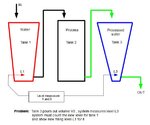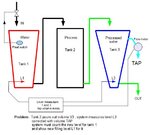anantj18
Newbie level 3
- Joined
- Aug 6, 2011
- Messages
- 4
- Helped
- 0
- Reputation
- 0
- Reaction score
- 0
- Trophy points
- 1,281
- Location
- Chennai,India
- Activity points
- 1,324
Hi i am trying to design a water tank system. Here the user pours water into one tank, the water after processing through the second tank, gets stored in the third tank. Now the challenge is that the amount of extra water that is poured into the first tank should be the amount of water coming out from the third tank. Can anyone give any suggestions ?

